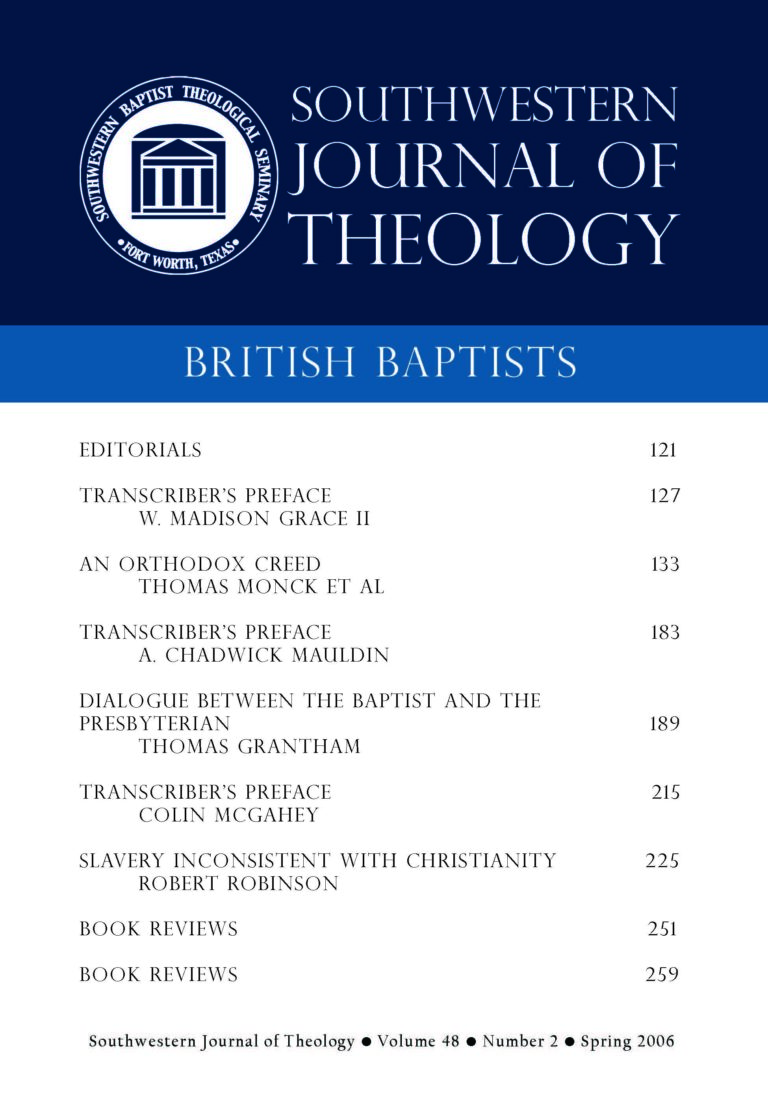
British Baptists
Southwestern Journal of Theology
Volume 48, No. 2 – Spring 2006
Managing Editor: Malcolm B. Yarnell III
Edited by Thomas White, Jason G. Duesing, and Malcolm B. Yarnell III. Grand Rapids, MI: Kregel Academic & Professional, 2008. 272 pages. Softcover, $18.99
As a local church minister for eight plus years, I have been deeply grieved on occasion by the spiritual condition of older, yet sometimes immature followers of Christ. Some problems have been easily diagnosed and remedied. Others have not. Needless to say for pastors like me, Restoring Integrity in Baptist Churches has hit the nail on the head. Challenging, convicting, applicable, and biblical are words to describe this work edited by White, Duesing, and Yarnell. It will remain close by my side for many years to come as I seek to restore integrity in the Baptist church I pastor.
After reading this work from cover to cover, many strengths are readily identifiable. First, the authors of the individual chapters are some of the best and brightest theologians in the Southern Baptist Convention. Three of our six Southern Baptist seminaries are represented along with one state Baptist university. Furthermore, this “dream team” of theologians includes one seminary president, three deans, and multiple professors.
Other strengths of this work are its timeliness, courage to address current and real issues, and applicability. As for timeliness, the Baptist church that I pastor has lost much of the influence that she once possessed in the community. Why is that? One of the prominent reasons is that the pagan world has witnessed her lack of integrity. Therefore, this book is needed not only in my church and in my hands but also in the hands of the forty-thousand plus pastors in the Southern Baptist Convention. As John Hammett notes in the volume, on any given Sunday in the morning worship service, approximately two-thirds of Southern Baptists are nowhere to be found (27). That is startling and a serious problem.
As to addressing current issues, many of the book’s contributors referenced controversies at Henderson Hills Baptist Church, Bethlehem Baptist Church, and within our own International Mission Board specifi- cally related to baptism and its subject, mode, place, and administrator. The authors then offered real solutions for real problems in real churches. As for applicability, these chapters not only answer the “what” and the “why,” but they answer the “how.” Particularly refreshing was Professor Norman’s step-by-step guide to reestablishing church discipline in a local congregation. Norman shares practical considerations for the reestablishment of church discipline including the adoption or revision of a church covenant and revising the church’s legal documents (212–214).
The last strength that deserves mention is the authors’ convincing appeal to a host of authoritative sources. Of course, for Southern Baptists, our final authority is the Word of God, and Restoring Integrity in Baptist Churches is chalked full of biblical references in their proper context. Dr. Akin (63) and Dr. Allen (95) set forth overwhelming evidence from the Scriptures for believer’s baptism by immersion. In addition, the authors have appealed to hundreds of years of church history in making their case for some of our most cherished and essential distinctives such as regenerate church membership and church discipline. On the acceptance of regenerate church membership, Hammett appeals to the Anabaptists, English Baptists, and the Somerset Confession of 1656 as proof that this practice is part of our heritage (25). As for church discipline, Norman points to multiple early Baptist confessions, including the Belgic Confession of 1561 and The First London Confession of Particular Baptists of 1644 that include statements on church discipline (202–206).
When it comes to areas of improvement, I mention only two. Pastor Mark Dever’s contribution to this book is one aspect that gives the volume potential wider reading among pastors. Even though many, if not all, of the other contributors have had extensive and successful local church ministries, there is often a perceived disconnect between pastors and academicians. Unfortunately pastors sometimes see professional theologians as having all the solutions while never encountering any of the problems on a local church level. While that is not the case in Restoring Integrity, the inclusion of more authors who are presently local church pastors would only strengthen and increase the book’s value among those of us serving in the churches.
The only other area of improvement in this author’s opinion was the absence of any discussion regarding the belief of the eternal security of the believer as it relates to baptism or the gospel. In my own congregation, there have always been questions about receiving Christians for membership from Assembly of God or Pentecostal backgrounds due to their belief in a Christian’s ability to lose or forfeit his or her salvation. Dr. White gives three paragraphs to Alien Immersion and includes some insightful thoughts about churches that do not normally immerse and if those bap- tisms should be accepted as valid (111–12, 117–118). However, nowhere does he address the issue of the church or the administrator’s belief in falling from grace or losing one’s salvation. Answers to this question might have been included in his chapter on baptism and the definition of a true church. They certainly would have benefited this pastor and provided clarity for some otherwise precarious situations.
Again, hats off to the editors and contributors to this fine volume that if read and practiced by Southern Baptist pastors could be the catalyst for a twenty-first century spiritual awakening and revival in America’s largest Protestant denomination.





